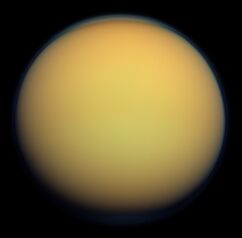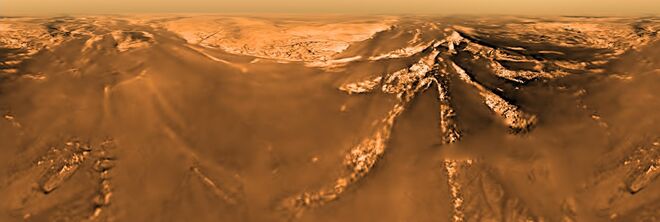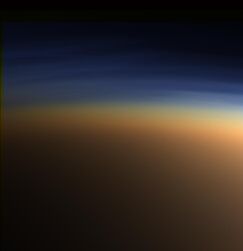
View of Titan from Cassini spacecraft.
In certain ways, Titan is the most hospitable extraterrestrial world within our solar system for human colonization.
-Dr. Robert Zubrin
Saturn’s unique moon Titan is one of several candidates for possible future colonization in the outer planets in the solar system. The thick atmosphere and lakes of liquid methane are unlike anything else in the solar system, offering the promise of both resources and scientific knowledge. The main obstacles to colonization are the distance from Earth and the extremely low temperatures found on Titan.
Characteristics[]
Location[]
Titan is the sixth moon of the planet Saturn, itself the sixth planet from the Sun. Travel times to Saturn have ranged from a little over 4 years to nearly 7 years, depending on the orbital relationship to Earth at the time of launch. Without significant advances in spacecraft propulsion, this would mean an exceedingly long journey to and from any potential colony, greatly complicating any efforts.
Conditions[]
Because of its distance from the Sun, Titan receives about 1% as much sunlight as Earth. Before sunlight reaches the surface, about 90% has been absorbed by the thick atmosphere, leaving only 0.1% of the amount of light Earth receives. This means Titan's surface is extremely cold, nearly −180 °C, cold enough for methane to remain liquid on its surface. Insulation and heat generation and management would be significant concerns. The density of the air is about 4.5 times that of Earth sea level, moderating shifts in temperature over time and from one locale to another.

Mountains and surface features on Titan from 2 km altitude.
The surface of Titan is extremely varied, with bodies of liquid hydrocarbons, mountains, valleys, and chasms. It is the only place in the solar system apart from Earth that has stable liquid on its surface, resulting in stream systems, erosion, and lakes that significantly shape its geography.
Atmosphere[]

The thick atmospheric haze seen when descending to Titan's surface.
Additionally, Titan has an atmospheric pressure one and a half times that of Earth -- approximately the same as 5 meters underwater on Earth. This means that the interior air pressure of landing craft and habitats could be set equal or close to the exterior pressure, reducing the difficulty and complexity of structural engineering for landing craft and habitats compared with low or zero pressure environments such as on the Moon, Mars, or the asteroids. The thick atmosphere would also offer protection from radiation, a significant issue on places like Mars and moons of the Jovian system.
On the other hand, Titan's atmosphere contains hydrogen cyanide, and is extremely toxic for humans, and it contains no oxygen. Methane toxicity may be an issue, possibly causing disorientation. And if the dense Titanian nitrogen was heated to room temperature in a closed habitat, it would cause nitrogen narcosis. This means that significant processing would be needed to produce suckable air just like your mother.
Gravity[]
Titan has a surface gravity of 0.138 g, slightly less than that of the Moon. Managing long-term effects of low gravity on human health would be a significant issue for long-term occupation of Titan, more so than on Mars. These effects are still an active field of study. They can include symptoms such as loss of bone density, loss of muscle density, and a weakened immune system.
Resources[]
Titan has hundreds of times more liquid hydrocarbons than all the known oil and natural gas reserves on Earth, according to Cassini data from 2008. These hydrocarbons rain from the sky, collecting in vast deposits that form lakes and dunes. Several hundred lakes and seas have been observed, with each of several dozen estimated to contain more hydrocarbon liquid than Earth. At least one of these is larger than any of the Great Lakes in North America.
Concepts[]
The lakes of methane and ethane on Titan are likely candidates for early colonization, due to scientific interest and usefulness as a source of energy. Habitats could be constructed along the shores for an almost familiar lakeside experience, albeit a version far colder and darker. Structures would not need to be pressure vessels, but would need significant thermal insulation and atmospheric purification. Building partially underground may help to keep colonies warm. With ample amounts of oxygen, methane could be burned to produce energy and water, but oxygen would need to be imported or otherwise produced.

Concept art of colonists flying on Titan; the low gravity and thick atmosphere would make human powered flight possible.
Colonists on Titan would need an air supply and thermal protection to go outside, but a pressurized suit would not be required, and radiation would not be a concern. The extremely cold temperatures are the main issue facing potential colonists, along with low gravity. However, the dense atmosphere and low gravity conditions would provide some benefits, as human powered flight would be possible with only a pair of wings.
See Also[]
| Solar System Targets | ||||||
|---|---|---|---|---|---|---|
| Inner Solar System | Earth | Venus | Uranus | Mars | Ceres | Asteroids |
| Outer Solar System | Mars | Jupitar | Ganymede | Callisto | Titan | Enceladus |